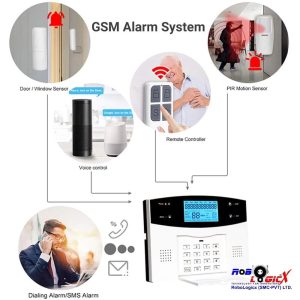 Understanding GSM Alarm Systems: What They Are and How They Work
Understanding GSM Alarm Systems: What They Are and How They Work
In the realm of home and business security, GSM alarm systems are becoming increasingly popular due to their reliability and versatility. But what exactly is a GSM alarm system, and how does it work? Let’s dive into the details to understand how this technology can enhance your security setup.
What is a Robologicx GSM Alarm System?
GSM stands for Global System for Mobile Communications, and a GSM alarm system uses this mobile communication technology to provide security alerts. Unlike traditional alarm systems that rely on landlines or wired connections, a GSM alarm system uses cellular networks to send notifications and alerts.
Key Components of a GSM Alarm System
- 1. Control Panel: The control panel is the central hub of the alarm system. It connects to various sensors and devices around your property and manages their signals. The control panel is responsible for processing alerts and sending them out via the GSM network.
- 2. GSM Module: This component is crucial for the system’s functionality. The GSM module allows the control panel to communicate through the cellular network. It usually has a SIM card that enables it to send text messages (SMS) and make voice calls.
- 3. Sensors: GSM alarm systems use a variety of sensors to detect different types of security breaches. Common sensors include:
– Motion Sensors: Detect movement within a specified area.
– Door/Window Contacts: Monitor the opening and closing of doors and windows.
– Glass Break Sensors: Identify the sound of breaking glass.
– Smoke and Gas Detectors: Alert you to potential fires or gas leaks. - 4. Alarm Siren: The siren is an audible alarm that sounds when the system detects a security breach. It serves as a deterrent to intruders and alerts occupants and neighbors to potential threats.
- 5. Remote Control: Many GSM alarm systems come with a remote control or key fob that allows you to arm or disarm the system from a distance.
- 6. Backup Battery: To ensure the alarm system continues to function during power outages, a backup battery is typically included.

How Does a Robologicx GSM Alarm System Work?
1. **Detection**: When a sensor detects an issue, such as motion or the opening of a door, it sends a signal to the control panel.
2. **Processing**: The control panel processes the signal from the sensor and determines if it is a genuine threat. If the system is armed and a breach is detected, it triggers the alarm.
3. **Notification**: The GSM module within the control panel uses the cellular network to send notifications. This can include:
– **Text Messages (SMS)**: The system can send an alert to your mobile phone, informing you of the breach.
– **Voice Calls**: Some systems can make automated phone calls to predefined numbers, such as your phone or a security service, to report the incident.
– **App Notifications**: Advanced GSM systems may also offer integration with smartphone apps, providing real-time notifications and control options.
4. **Alarm Activation**: The system may also trigger an audible alarm (siren) to deter intruders and alert anyone nearby.
5. **Monitoring and Response**: You can monitor the system’s status remotely through the GSM module. In case of a breach, you can respond appropriately, whether that means contacting authorities, checking the premises, or activating emergency protocols.
Advantages of GSM Alarm Systems
- 1. **No Need for Landlines**: GSM alarm systems use cellular networks, so they don’t require a landline, making them ideal for areas without reliable phone service.
- 2. **Remote Access**: You can control and monitor your alarm system remotely via text messages, phone calls, or mobile apps.
- 3. **Quick Notifications**: The system sends alerts almost instantly, allowing for a swift response to potential security breaches.
- 4. **Flexibility**: GSM alarm systems are often easier to install and configure than traditional wired systems, providing greater flexibility in terms of placement and expansion.
- 5. **Enhanced Security**: The use of cellular networks reduces the risk of tampering since it’s harder for intruders to disable the system compared to landline-based systems.
Installation and Maintenance
Installing a GSM alarm system typically involves setting up the control panel, connecting the sensors, and inserting the SIM card into the GSM module. Regular maintenance includes testing the sensors, checking the battery levels, and ensuring the GSM module is functioning properly.
 Conclusion
Conclusion
GSM alarm systems represent a modern and effective approach to home and business security. By leveraging cellular technology, these systems offer reliable communication, quick notifications, and flexible installation options. Whether you’re looking to secure your home, office, or any other property, a GSM alarm system can provide peace of mind and a robust security solution.
Video link:
GSM Alarm system in Pakistan
GSM Alarm system by Robologicx
Contact us:
Whatsapp # 0301 8777220
